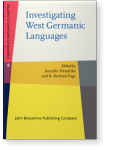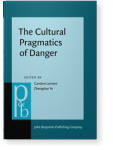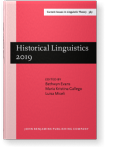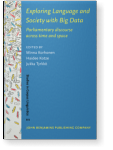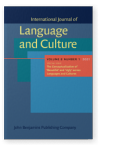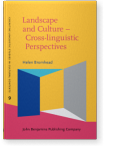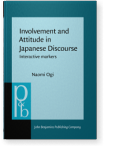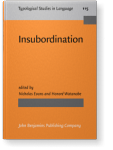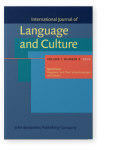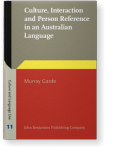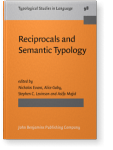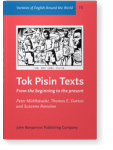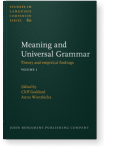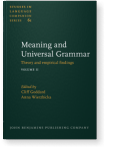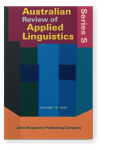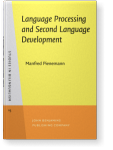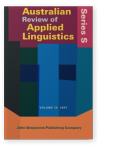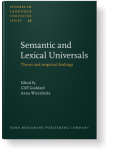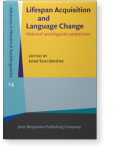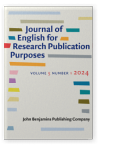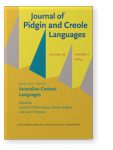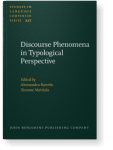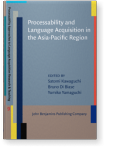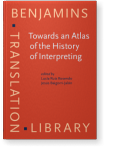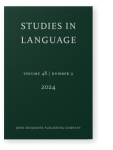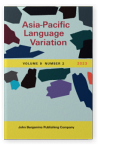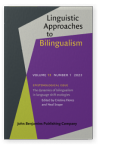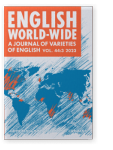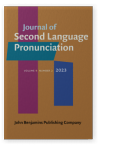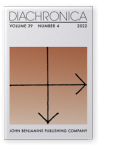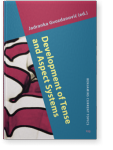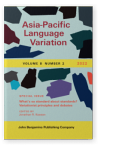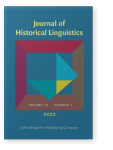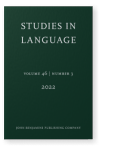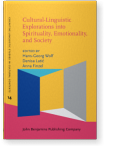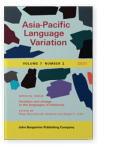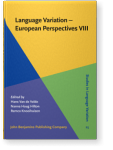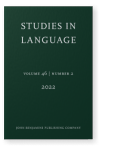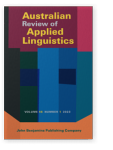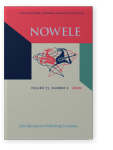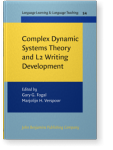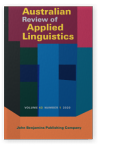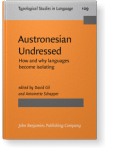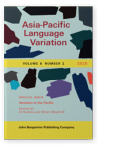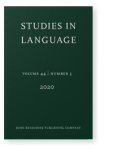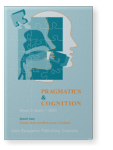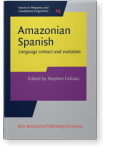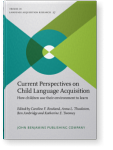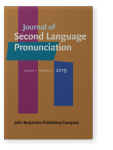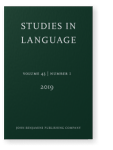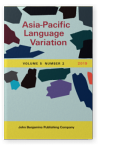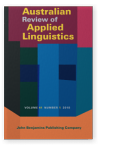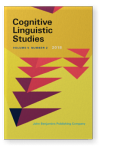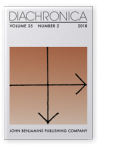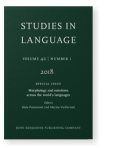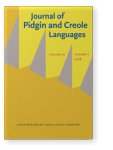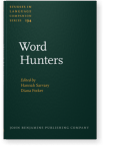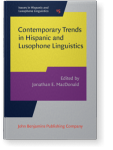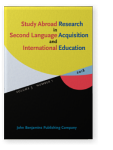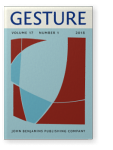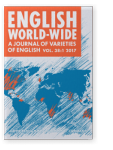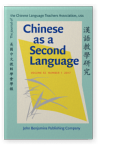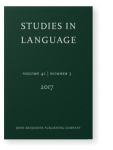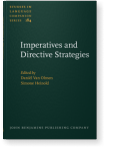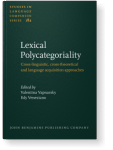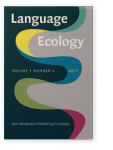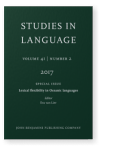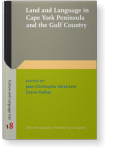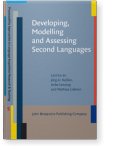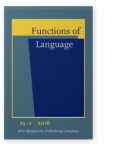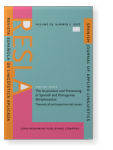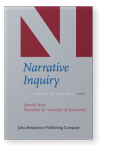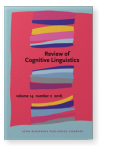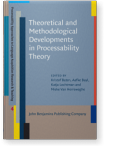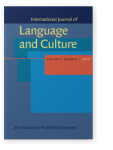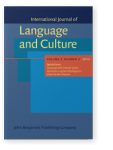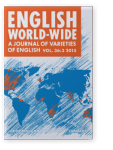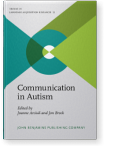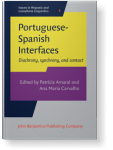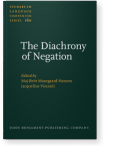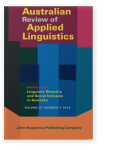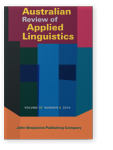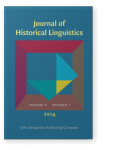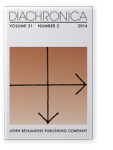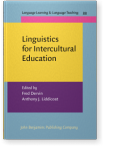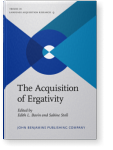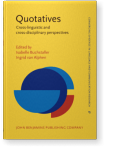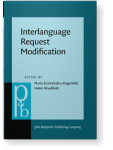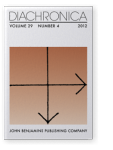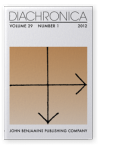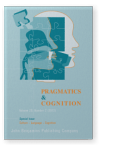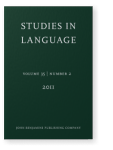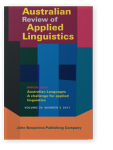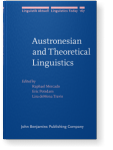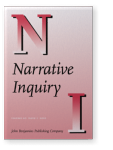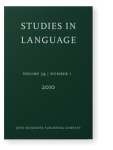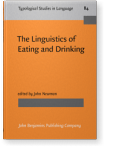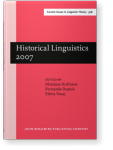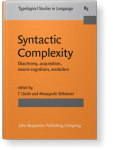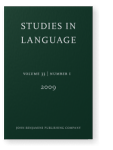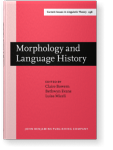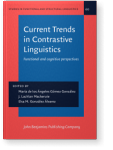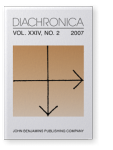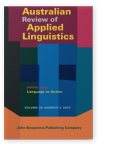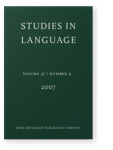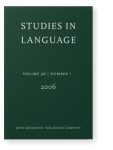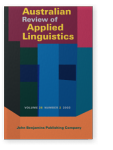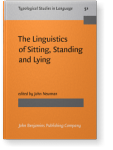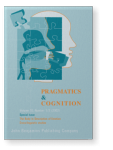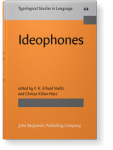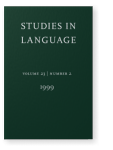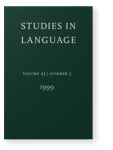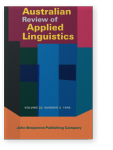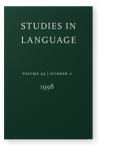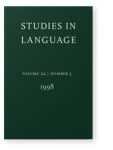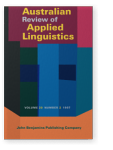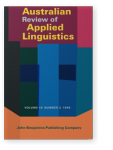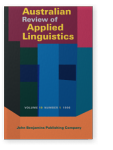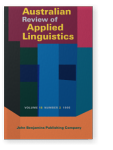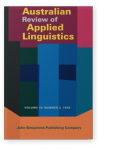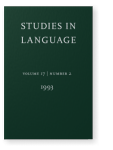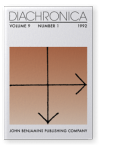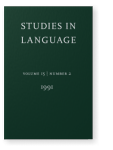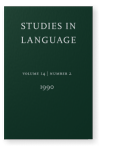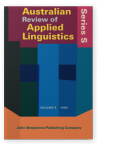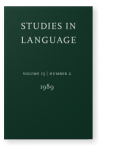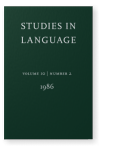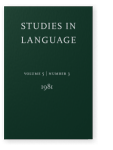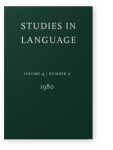Australian National University
List of John Benjamins publications for which someone affiliated with Australian National University plays a role.
The Cultural Pragmatics of Danger: Cross-linguistic perspectives
Edited by Carsten Levisen & Zhengdao Ye
[Pragmatics & Beyond New Series, 346] 2024. | edited volumeSubjects Discourse studies | Pragmatics
Historical Linguistics 2019: Selected papers from the 24th International Conference on Historical Linguistics, Canberra, 1–5 July 2019
Edited by Bethwyn Evans, Maria Kristina Gallego & Luisa Miceli
[Current Issues in Linguistic Theory, 367] 2024. | edited volumeSubjects Historical linguistics | Theoretical linguistics
Exploring Language and Society with Big Data: Parliamentary discourse across time and space
Edited by Minna Korhonen, Haidee Kotze & Jukka Tyrkkö
[Studies in Corpus Linguistics, 111] 2023. | edited volumeSubjects Corpus linguistics | Discourse studies | Pragmatics | Sociolinguistics and Dialectology
The Conceptualization of ‘Beautiful’ and ‘Ugly’ across Languages and Cultures: Special issue of the International Journal of Language and Culture 8:1 (2021)
Edited by Anna Gladkova & Jesús Romero-Trillo
[International Journal of Language and Culture, 8:1] 2021. | special issueSubjects Anthropological Linguistics | Applied linguistics | Cognition and language | PragmaticsCognitive psychology
Understanding language genealogy: Alternatives to the tree model. Special issue of the Journal of Historical Linguistics 9:1 (2019)
Edited by Siva Kalyan, Alexandre François & Harald Hammarström
[Journal of Historical Linguistics, 9:1] 2019. | special issueSubjects Historical linguistics
Landscape and Culture: Cross-linguistic Perspectives
Helen Bromhead
[Cognitive Linguistic Studies in Cultural Contexts, 9] 2018. | monographSubjects Anthropological Linguistics | Cognition and language | Semantics
Involvement and Attitude in Japanese Discourse: Interactive markers
Naomi Ogi
[Pragmatics & Beyond New Series, 272] 2017. xi, 232 pp. | monographSubjects Discourse studies | Japanese linguistics | Pragmatics | Syntax | Theoretical linguistics
Insubordination
Edited by Nicholas Evans & Honoré Watanabe
[Typological Studies in Language, 115] 2016. xii, 435 pp. | edited volumeSubjects Semantics | Syntax | Theoretical linguistics | Typology
“Happiness” and “Pain” across Languages and Cultures
Edited by Cliff Goddard & Zhengdao Ye
[Benjamins Current Topics, 84] 2016. vi, 145 pp. | edited volumeSubjects Anthropological Linguistics | Cognition and language | Semantics | Sociolinguistics and Dialectology
"Happiness" and "Pain" across Languages and Cultures: Special issue of International Journal of Language and Culture 1:2 (2014)
Edited by Cliff Goddard & Zhengdao Ye
[International Journal of Language and Culture, 1:2] 2014. | special issueSubjects Anthropological Linguistics | Applied linguistics | Cognition and language | PragmaticsCognitive psychology
Culture, Interaction and Person Reference in an Australian Language: An ethnography of Bininj Gunwok communication
Murray Garde
[Culture and Language Use: Studies in Anthropological Linguistics, 11] 2013. xx, 274 pp. | monographSubjects Anthropological Linguistics | Australian languages | Pragmatics | Sociolinguistics and Dialectology | Syntax
Functional-Historical Approaches to Explanation: In honor of Scott DeLancey
Edited by Tim Thornes, Erik Andvik, Gwendolyn Hyslop & Joana Jansen
[Typological Studies in Language, 103] 2013. xviii, 294 pp. | edited volumeSubjects Functional linguistics | Historical linguistics | Typology
Relative Clauses in Time and Space: A case study in the methods of diachronic typology
Rachel Hendery
[Typological Studies in Language, 101] 2012. xii, 281 pp. | monographSubjects Historical linguistics | Syntax | Theoretical linguistics | Typology
Reciprocals and Semantic Typology
Edited by Nicholas Evans, Alice Gaby, Stephen C. Levinson & Asifa Majid
[Typological Studies in Language, 98] 2011. viii, 349 pp. | edited volumeSubjects Semantics | Theoretical linguistics | Typology
Australian Languages: Classification and the comparative method
Edited by Claire Bowern & Harold Koch
[Current Issues in Linguistic Theory, 249] 2004. xii, 377 pp. (incl. CD-Rom) | edited volumeSubjects Australian languages | Historical linguistics
Tok Pisin Texts: From the beginning to the present
Peter Mühlhäusler, Thomas E. Dutton & Suzanne Romaine
[Varieties of English Around the World, T9] 2003. x, 284 pp. | monographSubjects Creole studies | English linguistics | Germanic linguistics | Sociolinguistics and Dialectology
Meaning and Universal Grammar: Theory and empirical findings. Volume 1
Edited by Cliff Goddard & Anna Wierzbicka
[Studies in Language Companion Series, 60] 2002. xvi, 337 pp. | edited volumeSubjects Semantics | Theoretical linguistics | Typology
Meaning and Universal Grammar: Theory and empirical findings. Volume 2
Edited by Cliff Goddard & Anna Wierzbicka
[Studies in Language Companion Series, 61] 2002. xvi, 337 pp. | edited volumeSubjects Semantics | Theoretical linguistics | Typology
Issues in the Teaching and Learning of Japanese
Edited by Nicolette Bramley & Naoko Hanamura
[Australian Review of Applied Linguistics. Series S, 15] 1998. | yearbookSubjects Applied linguistics | Language acquisition | Language teaching
Language Processing and Second Language Development: Processability theory
Manfred Pienemann
[Studies in Bilingualism, 15] 1998. xviii, 366 pp. | course bookSubjects Multilingualism
Teaching Languages, Teaching Culture
Edited by Anthony J. Liddicoat & Chantal Crozet
[Australian Review of Applied Linguistics. Series S, 14] 1997. | yearbookSubjects Applied linguistics | Language acquisition | Language teaching
Semantic and Lexical Universals: Theory and empirical findings
Edited by Cliff Goddard & Anna Wierzbicka
[Studies in Language Companion Series, 25] 1994. viii, 510 pp. | edited volumeSubjects Functional linguistics | Semantics
2024 The dynamics of lifelong acquisition in dialect contact and
change
In: Lifespan Acquisition and Language Change: Historical sociolinguistic perspectives[Advances in Historical Sociolinguistics, 14] p. 84
Keywords dialect contact | lifespan change | language dominance | linguistic repertoire | crosslinguistic transfer
2024 The influences of adult and child speakers in the emergence of
Light Warlpiri, an Australian mixed language
In: Lifespan Acquisition and Language Change: Historical sociolinguistic perspectives[Advances in Historical Sociolinguistics, 14] pp. 179–202
Keywords Warlpiri | Light Warlpiri | acquisition | child language | Australia | mixed language | language contact | innovation
2024 Investigating change from a perspective of continuity: Dutch two-verb clusters in sixteenth-century Antwerp
In: Investigating West Germanic Languages: Studies in honor of Robert B. Howell[Studies in Germanic Linguistics, 8] pp. 188–224
Keywords data biases | sociohistorical change | dialect contact | sixteenth-century Antwerp | verb clusters
2024 “When bad things happen to people”: Cultural pragmatics and cross-linguistic perspectives on danger
In: The Cultural Pragmatics of Danger: Cross-linguistic perspectives[Pragmatics & Beyond New Series, 346] pp. 1–22
Keywords cultural pragmatics | discourse studies | discourse of danger | linguaculture | cross-linguistic studies | cultural keywords | cultural scripts | global crisis
2024 The cultural pragmatics of “danger” in Chinese political discourse
In: The Cultural Pragmatics of Danger: Cross-linguistic perspectives[Pragmatics & Beyond New Series, 346] pp. 194–216
Keywords cultural pragmatics | state political discourse | natural semantic metalanguage (NSM) | discourse of danger | cultural scripts | Chinese elite politics | discourse studies | analysis of political discourse
2024
Security, Sicherheit, ānquán
: Similar-but-different key concepts in English, German and Chinese
In: The Cultural Pragmatics of Danger: Cross-linguistic perspectives[Pragmatics & Beyond New Series, 346] pp. 217–235
Keywords security concepts | lexical semantics | discourse of security | natural semantic metalanguage (NSM) | German | Chinese
2024 Superheroes, war heroes, health care heroes: The pragmatics of danger and the discourse of heroism
In: The Cultural Pragmatics of Danger: Cross-linguistic perspectives[Pragmatics & Beyond New Series, 346] p. 86
Keywords semantics | discourse analysis | natural semantic metalanguage | hero | cultural keywords | English | Anglosphere
2024 10 tips for getting past desk screening and out to reviewers
Keywords review processes | desk reject | editor perspective | research writing
2024 After 1788*
: Contact varieties in the first sixty years of Australia’s colonisation
Keywords Australian Indigenous languages | Australian English-lexified contact varieties | NSW pidgin | English foreigner talk | learner English | historical linguistics | slang | nautical jargon
2024 Indigenous Language Ecologies framework: A tool for inserting Indigenous contact languages and their speakers into policy in Australia
Keywords contemporary Aboriginal and Torres Strait Islander languages and multilingualisms | Indigenous language policy | First Nations language ecologies | Indigenous Australian contact languages | creoles in language policy | creoles in language planning | linguistic diversity in policy | unrepresentative language data | multilingual language policy | linguistics and policy
2024 Source language influences in the Australian mixed language, Light Warlpiri
Keywords mixed language | Australia | Warlpiri | Light Warlpiri | Kriol | English
2024 Solving Galton’s problem: Practical solutions for analysing language diversity and evolution
In: Historical Linguistics 2019: Selected papers from the 24th International Conference on Historical Linguistics, Canberra, 1–5 July 2019[Current Issues in Linguistic Theory, 367] p. 75
Keywords cross-cultural analysis | Galton | phylogenetic non-independence | language diversity
2024 Recurrent change in pronouns: The case of Western Oceanic subject markers
In: Historical Linguistics 2019: Selected papers from the 24th International Conference on Historical Linguistics, Canberra, 1–5 July 2019[Current Issues in Linguistic Theory, 367] pp. 147–172
Keywords recurrent change | historical linguistics | grammaticalisation | morphology | Oceanic | pronouns | paradigm formation
2023 Salient differences between Australian oral parliamentary discourse and its official written records: A comparison of ‘close’ and ‘distant’ analysis methods
In: Exploring Language and Society with Big Data: Parliamentary discourse across time and space[Studies in Corpus Linguistics, 111] pp. 54–88
Keywords Australian Hansard | close reading | distant reading | editorial practice | informality | conservatism | spoken language
2023 The function of names: A case study of usage in Japanese original TV dramas and Korean
remakes
In: It’s different with you: Contrastive perspectives on address research[Topics in Address Research, 5] pp. 35–60
Keywords Japanese | Korean | name | identification | social relationship | TV drama
2023 Recognising Yarrie Lingo, the creole language of Yarrabah community in far north-eastern Queensland
Australia
Keywords Yarrie Lingo | Yarrabah Creole | Australian creoles | pidgin and creole languages | language recognition | language awareness | language shift | creoles in education | English as a Second Language for creole speakers | grounded language research methodology
2023 Are referent introductions sensitive to forward planning in discourse?: Evidence from Multi-CAST
In: Discourse Phenomena in Typological Perspective[Studies in Language Companion Series, 227] pp. 231–268
Keywords reference processing | grammatical relations | discourse structure | thematic prominence | discourse topic | referent introduction | corpus-based typology
2023 Interpreters of mission: How indigenous peoples shaped mission projects across Australia and the Pacific
In: Towards an Atlas of the History of Interpreting: Voices from around the world[Benjamins Translation Library, 159] pp. 193–211
Keywords Australia | Pacific | missions | colonisation | interpreting | Christianity
2023 Comparing zero and referential choice in eight languages with a focus on Mandarin Chinese
Keywords Mandarin Chinese | zero arguments | corpus analysis | usage-based approach | referential choice
2024 Directional constructions in Matukar Panau: A Bayesian approach to assessing variation
Keywords Bayesian regression | Oceanic | directionals | serial verbs | morphosyntactic variation | grammaticalization | lexicalization | corpus linguistics
2023 Stability and change in (ing): Ethnic and grammatical variation over time in Australian English
Keywords (ing) | social class | ethnic variation | real- and apparent-time | language change | stable variable | Australian English
2022 Is Malayo-Polynesian a primary branch of Austronesian?: A view from morphosyntax
Keywords Austronesian higher-order subgrouping | Malayo-Polynesian | East Formosan | syntactic reanalysis | Austronesian diaspora | Out-of-Taiwan Hypothesis | triangulation
2022 The role of older men in a phonological change: (ɣ) in Raga, Vanuatu
Keywords Oceanic language | phonetic variation | language change | apparent-time study | gender variation | v-shaped pattern | velar fricative | consonant deletion | diachronic change
2021 Pathways of initial consonant loss: A Middle Paman case study
Keywords initial consonant loss | Pama-Nyungan | Middle Paman
2021 Conjunctions and clause linkage in Australian languages: A typological study
Keywords conjunctions | clause linkage | Australian languages | typology
2021
essentials and valuables
: Cultural conceptualizations of Cantonese rice
idioms
In: Cultural-Linguistic Explorations into Spirituality, Emotionality, and
Society[Cognitive Linguistic Studies in Cultural Contexts, 14] pp. 237–266
Keywords Cantonese rice idioms | cultural conceptualizations | conceptual processing | idiomaticity | Cantonese worldview
2021 Gender, mobility and contact: Stability and change in an Acehnese dialect
Keywords variation and change | language contact | mobility | sociophonetics | glottalization | Acehnese | Indonesian | variasi dan perubahan bahasa | kontak bahasa | mobilitas | sosiofonetik | glotalisasi | Bahasa Aceh | Bahasa Indonesia
2021 Is ugliness in the mind of the beholder?: The conceptualization of ‘ugly’ in English
Keywords corpus pragmatics | folk aesthetics | English | natural semantic metalanguage (NSM) | ugly | polysemy
2021 The linguistic conceptualization in folk aesthetics: Past, present and future
Keywords folk aesthethics | linguistic variation | language and culture | beautiful | ugly
2021 “What is beauty?”: Cultural semantics of the Russian folk aesthetics
Keywords cultural semantics | folk aesthetics | Russian | natural semantic metalanguage (NSM) | beautiful | ugly | polysemy | politeness
2021 Ethnic variation in real time: Change in Australian English diphthongs
In: Language Variation – European Perspectives VIII: Selected papers from the Tenth International Conference on Language Variation in Europe (ICLaVE 10), Leeuwarden, June 2019[Studies in Language Variation, 25] pp. 291–314
Keywords ethnolects | ethnic variation | diphthongs | Australian English | language change | gender | socio-economic status
2021 Predicting voice choice in symmetrical voice languages: All the things that do not work in Totoli
Keywords western Austronesian | symmetrical voice | voice choice | discourse | Totoli
2021 Should Munanga learn Kriol?: Exploring attitudes to non-Indigenous acquisition of Kriol language in Ngukurr
Keywords Kriol | language attitudes | language acquisition | Indigenous Australian languages | contact languages
2020 Adaptive imitation: Formulaicity and the words of others in L2 English academic
writing
In: Complex Dynamic Systems Theory and L2 Writing Development[Language Learning & Language Teaching, 54] p. 81
Keywords formulaic language | imitation | second language writing | academic literacy
2020 The impact of learning context on L2 Chinese word order structure development: From the beginning
Study Abroad Research in Second Language Acquisition and International Education 5:2 pp. 258–280 | article
Keywords learning context |
ab-initio learners | learning processes | acquisition sequences | rate of learning word order
2020 “Switching caps”: Two ways of communicating in sign in the Port Moresby deaf community, Papua New Guinea
Keywords sign language | bilingualism | translanguaging | Papua New Guinea | metalinguistics
2020 “What we do and don’t do”: Defining team in the discourse of academic learning advisers’ post-consultation notes
Keywords community of practice | workplace discourse | academic language and learning | professional identity | higher education
2020 Becoming Austronesian: Mechanisms of language dispersal across southern Island Southeast Asia and the
collapse of Austronesian morphosyntax
In: Austronesian Undressed: How and why languages become isolating[Typological Studies in Language, 129] pp. 447–482
Keywords language contact | creolisation | substrate | family profile | typology | Island Southeast Asia | Austronesian
2020 Borrowing from Bislama into Raga, Vanuatu: Borrowing frequency, adaptation strategies and semantic considerations
Keywords borrowing | loanword | Oceanic linguistics | Raga | Vanuatu | variation | Bislama | nativisation | quantitative study | minority language
2020 Discontinuous noun phrases in Ngkolmpu
Keywords discontinuity | information-structure | Papuan | Yam | Kanum
2021 Feeling through your chest: Body-based tropes for emotion in Anindilyakwa
Keywords emotion | metaphor | body | Anindilyakwa | Australian Indigenous languages
2021 The role of the body in descriptions of emotions: A typology of the Australian continent
Keywords figurative language | metaphors | metonymies | body parts | emotions | linguistic typology | Australian languages
2020 Word-initial [h]-drop variation in Nmbo: Change-in-progress in an egalitarian multilingual speech community of Papua New Guinea
Keywords Papua New Guinea | Pacific | exogamy | deletion | lenition | phonological variation | network analysis | egalitarian multilingualism | apparent time construct
2020 Clitics and argument marking in Shipibo-Spanish and Ashéninka-Perené-Spanish bilingual speech
In: Amazonian Spanish: Language contact and evolution[Issues in Hispanic and Lusophone Linguistics, 23] pp. 127–154
Keywords clitic doubling | differential object marking | argument systems | bilingual acquisition | typological differences | Amazonian Spanish
2020 Development of aspect markers in Arandic languages, with notes on associated motion
Keywords associated motion | attenuative | continuous | habitual | nominalisation | reduplication
2019 Exploring the effects of instruction on L2 French learner pronunciation, accentedness, comprehensibility, and
fluency: An online classroom study
Keywords L2 pronunciation instruction | French as a foreign language | experimental L2 classroom experiment | accentedness | comprehensibility | fluency
2019 Subgrouping the Sogeram languages: A critical appraisal of Historical Glottometry
Keywords Historical Glottometry | subgrouping | language diversification | comparative reconstruction | Sogeram languages | Madang languages | Papuan languages
2020 The biblical roots of English ‘love’: The concept of ‘love’ in a historical and cross-linguistic perspective
Keywords the meaning of ‘love’ | NSM | Minimal English | New Testament | from Hebrew ’āhēb to Greek agapao
2020 Variation in Matukar Panau kinship terminology
Keywords Oceanic | possession | kinship | classifiers | random forest | mixed-effects regression
2020 Variation in the reflexive in Australian Kriol
Keywords Kriol | dialectology | reflexives | classification trees | random forests | Boruta | variation in contact languages | geographic variation | pidgin and creole languages | perceptual dialectology
2018 Can cultural scripts be used for teaching interactional norms?
Keywords natural semantic metalanguage | cultural scripts | English language teaching | teaching methods | migrant education | English as a second language | invisible culture | interactional norms | pragmatic awareness | cultural competence
2019 Cross-cultural conceptualizations of ageing in Australia
Keywords Cultural Linguistics | cultural conceptualizations | ageing | Anglo-Australian | Chinese-Australian
2018 When grammaticalization does not occur: Prosody-syntax mismatches in Indo-Aryan
Keywords grammaticalization | prosodic phrasing | Indo-Aryan | Indo-European | local particles | adverbs | adpositions
2018 Lexical semantics in language shift: Comparing emotion lexica in Dalabon and Barunga Kriol (northern Australia)
Keywords creole | lexical resemblance | lexical typology | substrate influence
2018 A preliminary typology of emotional connotations in morphological diminutives and augmentatives
Keywords evaluative morphology | diminutive | augmentative | expressivity | emotions
2018 Subcategorization and change: A diachronic analysis of sin embargo (de que)
In: Contemporary Trends in Hispanic and Lusophone Linguistics: Selected papers from the Hispanic Linguistic Symposium 2015[Issues in Hispanic and Lusophone Linguistics, 15] pp. 31–48
Keywords concessive | clausal complementation | change | subcategorization | Spanish
2018 Expressive values of reduplication in Barunga Kriol (northern Australia)
Keywords reduplication | expressivity | creole | emotions | aspect
2018 Leave-taking in Indonesian during short-term study abroad
Study Abroad Research in Second Language Acquisition and International Education 3:1 p. 84 | article
Keywords interlanguage pragmatics | study abroad | leave-taking | pragmatic routines | Indonesian
2018 Pointing to the body: Kin signs in Australian Indigenous sign languages
Keywords Australian Indigenous languages | sign language typology | kinship | bimodal contact
2017 Can you t[æ]ll I’m from M[æ]lbourne?: An overview of the dress and trap vowels before /l/ as a regional accent marker in Australian
English
Keywords Australian English | sound change | vowel merger | speech production | speech perception | regional variation
2017 从“知其然” 到“知其所以然”: 在语言教学中培养思辨能力
Keywords 人文教育 | 思辨能力 | 课堂互动 | 外语教学 | 课程设置 | liberal arts education | critical thinking | classroom interaction | foreign language pedagogy | syllabus design
2017 A method for mitigating the problem of borrowing in syntactic reconstruction
Keywords comparative method | syntactic reconstruction | Papuan languages | Madang languages | Sogeram languages | subordination | grammatical borrowing | desiderative construction
2017 Flexibles and polyvalence in Ku Waru: A developmental perspective
In: Lexical Polycategoriality: Cross-linguistic, cross-theoretical and language acquisition approaches[Studies in Language Companion Series, 182] pp. 307–341
Keywords child language acquisition | word classes | serial verb constructions | Papuan languages | longitudinal study
2017 Searching for “Agent Zero”: The origins of a relative case system
Keywords case system | Gurindji Kriol | language contact | language change | child language | children’s agency
2016 Exploring “happiness” and “pain” across languages and cultures
Keywords cross-linguistic semantics | happiness studies | language and culture. | Natural Semantic Metalanguage (NSM) | pain research
2016 Some remarks on “pain” in Latin American Spanish
Keywords cross-cultural psychology | Natural Semantic Metalanguage (NSM) | pain | Spanish
2016 The meaning of “happiness” (xìngfú) and “emotional pain” (tòngkŭ) in Chinese
Keywords Chinese corpora | Chinese emotion | happiness studies | Natural Semantic Metalanguage (NSM) | pain | subjective well-being
2016 “Pain” and “suffering” in cross-linguistic perspective
Keywords Buddhism | Christianity | crying | laughing | Natural Semantic Metalanguage (NSM) | pain | suffering
2017 Object agreement marking and information structure along the Quechua-Spanish contact continuum
Revista Española de Lingüística Aplicada/Spanish Journal of Applied Linguistics 29:2 pp. 544–581 | article
Keywords monolingual and bilingual contact varieties | syntax | information structure | object agreement markers | direct object clitics
2017 Ten postulates concerning narrative in Aboriginal Australia
Keywords Aboriginal Australia | narrative comparison | Dreamtime | Indigenous narrative | narrative inquiry
2017 “Walking” and “running” in English and German: The conceptual semantics of verbs of human locomotion
Keywords contrastive semantics | conceptual semantics | lexical polysemy | Manner | verbs of motion | semantic template | Natural Semantic Metalanguage (NSM)
2015 A whole cloud of culture condensed into a drop of semantics: The meaning of the German word Herr as a term of address
Keywords terms of address | Natural Semantic Metalanguage (NSM) | semantic evolution | cross-linguistic semantics | language and culture.
2015 The Trinidadian ‘Theory of Mind’: Personhood and postcolonial semantics
Keywords postcolonial semantics | ethnolexicology | ethnopsychology | ‘Theory of Mind’ | Trinidadian Creole | Anglo English
2015 “Scottish”, “English” or “foreign”: Mapping Scottish dialect perceptions
Keywords perceptual dialectology | folk linguistics | Scotland | language ideology | Scots | Scottish English | language and culture
2014 Dodgy data, language invisibility and the implications for social inclusion: A critical analysis of indigenous student language data in Queensland schools
Keywords English as an Additional Language/Dialect (EAL/D) | Indigenous education | multilingual education | student assessment | school language data
2014 Exploring “happiness” and “pain” across languages and cultures
Keywords cross-linguistic semantics | pain research | language and culture. | Natural Semantic Metalanguage (NSM) | happiness studies
2014 Personal growth as a strong element in the motivation of Australian university students to learn German
Keywords language learning motivation | qualitative research | German | university students | Ideal L2 Self
2014 Reconstructing the history of languages in northwest New Britain: Inheritance and contact
Keywords comparative method | language shift | Papuan | Oceanic Austronesian | contact-induced change
2014 Some remarks on “pain” in Latin American Spanish
Keywords | Spanish | cross-cultural psychology | Natural Semantic Metalanguage (NSM) | pain
2014 The meaning of “happiness” (xìngfú) and “emotional pain” (tòngkŭ) in Chinese
Keywords Chinese emotion | Chinese corpora | Natural Semantic Metalanguage (NSM) | happiness studies | pain | subjective well-being
2014 “Pain” and “suffering” in cross-linguistic perspective
Keywords pain | laughing | crying | Natural Semantic Metalanguage (NSM) | suffering | Christianity | Buddhism
2012 New methodologies for historical linguistics?: Calibrating a lexicon-based methodology for diffusion vs. subgrouping
Keywords Austronesian | Polynesian | areality | computational methods | historical linguistics | lexical borrowing
2012 Re-examining the ‘origins’ of the prenominal periphrastic possessive construction Jan z’n boek in Dutch: An empirical approach
Keywords prenominal periphrastic possessive constructions | case marking strategies | possessive constructions | relational case | case attraction | concordial case | German | Dutch
2013 Understanding others requires shared concepts
Keywords kinship | Cultural scripts | polysemy | natural semantics metalanguage (NSM) | numbers | universal human concepts | psychological concepts | semantic universals
2010 ‘Story’ — An English cultural keyword and a key interpretive tool of Anglo culture
Keywords NSM semantic theory | Anglo culture | cultural semantics | life story | story vs. history | chirographic culture | narrative turn
1996 The Influence of Culture in Search Conferences: A Rare Case of Fight/Flight
Keywords Laissezfaire. | Dissociation | Design Principles | Culture | Bion's Dynamics | Basic Group Assumptions | Community | Communication
